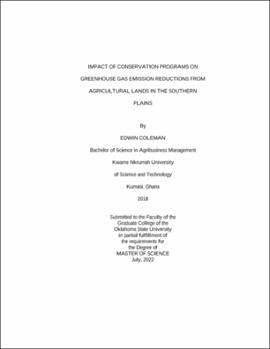| dc.description.abstract | As research provides continuing alarming claims about the dangers of climate change, greater interest is being focused on the contribution of agriculture and its potential to reduce greenhouse gas emissions (GHGs). The Natural Resource Conservation Service (NRCS) administers a suite of conservation programs that provide a variety of environmental benefits, including the reduction of GHG emissions. As the legislation and funding of these programs change, enrollment in these programs change in tandem, as will GHG emission reductions. After the 2018 Farm Bill was passed, some are questioning its impact on these emission reductions. The purpose of this research is to estimate the total GHG emission reductions due to enrollment in NRCS conservation programs for the years 2014 – 2020 from agricultural lands for the states of Kansas, Oklahoma, and Texas. Two types of data are combined to achieve this objective. One is enrollment data, detailing the number of acres in each county enrolled in various NRCS programs. The other data are obtained from the Comet-Planner model, which provides county-level estimates of the amount of reduction in GHGs per year for each acre engaged in a conservation practice. The results indicate that a few NRCS programs experienced considerable changes in enrollment from 2014 – 2020. Examples are conservation crop rotation (34% decrease) and convention tillage to no-till (47% decrease). The biggest change in enrollment is in the establishment of seasonal cover crops, where acres enrolled rose by 318%. Total emission reductions in these three states directly attributable to NRCS program enrollment in 2014 was 704,312 megagrams of CO2-equivalent GHGs, which is the equivalent of removing 150,000 cars from the road, or 10,000 households becoming carbon neutral. These emission reductions fell in the two subsequent years, equaling 579,138 megagrams of CO2-equivalent in 2016. However, after 2016 emission reductions began rising, such that in 2019 and 2020 they approximately equaled their 2014 level. | |
